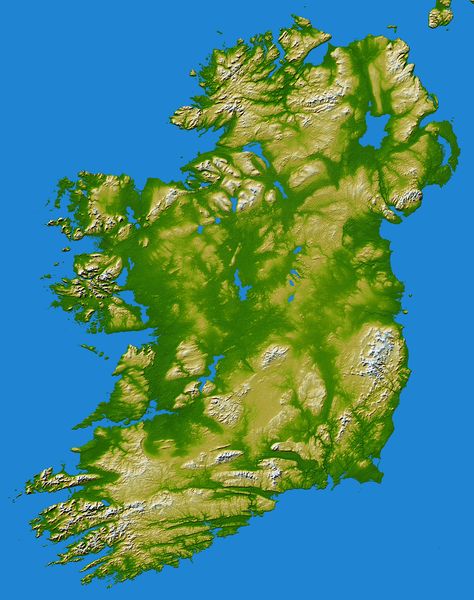Multimediaexpo.cz je již 18 let na českém internetu !!
V tiskové zprávě k 18. narozeninám brzy najdete nové a zásadní informace.
Soubor:Topography Ireland.jpg
Z Multimediaexpo.cz

Velikost tohoto náhledu je: 474 × 600 pixelů
Obrázek ve vyšším rozlišení (rozměr: 6 587 × 8 336 pixelů, velikost souboru: 6,49 MB, MIME typ: image/jpeg)
Mapa + Description:
- English: Elevation data in this topographical image of Ireland were acquired by the Shuttle Radar Topography Mission on board the STS-99 flight of the Space Shuttle Endeavour, launched on 11 February 2000.
The island of Ireland comprises a large central lowland of limestone with a relief of hills surrounded by a discontinuous border of coastal mountains which vary greatly in geological structure. The mountain ridges of the south are composed of old red sandstone separated by limestone river valleys. Granite predominates in the mountains of Counties Galway, Mayo, and Donegal in the west and north-west and in Counties Down and Wicklow on the east coast, while a basalt plateau covers much of the north-east of the country. The central plain, which is broken in places by low hills, is extensively covered with glacial deposits of clay and sand. It has considerable areas of bog and numerous lakes. The island has seen at least two general glaciations and everywhere ice-smoothed rock, mountain lakes, glacial valleys and deposits of glacial sand, gravel and clay mark the passage of the ice.
Two visualisation methods were combined to produce this image: shading and colour coding of topographic height. The shade image was derived by computing topographic slope in the northwest-southeast direction, so that northwest slopes appear bright and southeast slopes appear dark. Colour coding is directly related to topographic height, with green at the lower elevations, rising through yellow and tan, to white at the highest elevations.
Elevation data used in this image were acquired by the Shuttle Radar Topography Mission on board the Space Shuttle Endeavour, launched on 11 February 2000. SRTM used the same radar instrument that comprised the Spaceborne Imaging Radar-C/X-Band Synthetic Aperture Radar (SIR-C/X-SAR) that flew twice on the Space Shuttle Endeavour in 1994. SRTM was designed to collect 3-D measurements of the Earth's surface. To collect the 3-D data, engineers added a 60-metre (approximately 200-foot) mast, installed additional C-band and X-band antennas, and improved tracking and navigation devices. The mission was a cooperative project between NASA, the National Geospatial-Intelligence Agency (NGA) of the U.S. Department of Defense and the German and Italian space agencies. It was managed by NASA's Jet Propulsion Laboratory, Pasadena, California, for NASA's Earth Science Enterprise, Washington, D.C.
- Location: 53.5 degrees North latitude, 8 degrees West longitude
- Orientation: North toward the top, Mercator projection
- Image Data: shaded and coloured SRTM elevation model
- Date: February 2000
- Source: NASA — https://photojournal.jpl.nasa.gov/catalog/?IDNumber=PIA06672
- Author: NASA/JPL/NGA
NASA copyright policy states that "NASA material is not protected by copyright unless noted".
(Use of NASA logos, insignia and emblems is restricted per U.S. law 14 CFR 1221)
Historie souboru
Kliknutím na datum a čas se zobrazí tehdejší verze souboru.
| Datum a čas | Náhled | Rozměry | Uživatel | Komentář | |
|---|---|---|---|---|---|
| současná | 12. 8. 2018, 13:21 |  | 6 587×8 336 (6,49 MB) | Sysop (diskuse | příspěvky) | (Fotografie + ) |
- Editovat tento soubor v externím programu (Více informací najdete v nápovědě pro nastavení.)
Odkazy na soubor
Na soubor odkazuje tato stránka:
